She was feeling alone and isolated
VerifiedAdded on 2022/09/18
|8
|2263
|26
AI Summary
Contribute Materials
Your contribution can guide someone’s learning journey. Share your
documents today.

Transition
Name
ID
Course
Unit
Lecturer
Date
Name
ID
Course
Unit
Lecturer
Date
Secure Best Marks with AI Grader
Need help grading? Try our AI Grader for instant feedback on your assignments.
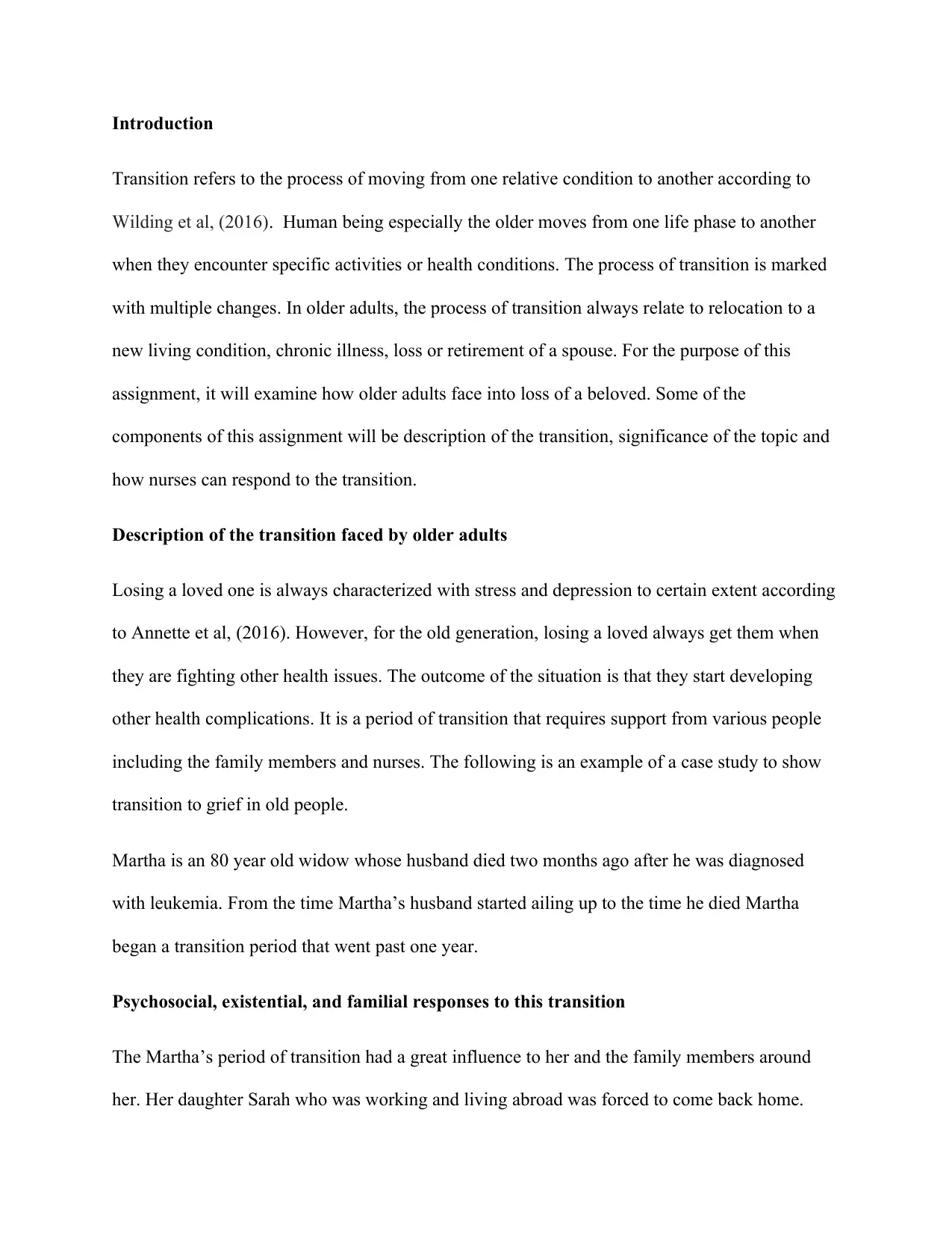
Introduction
Transition refers to the process of moving from one relative condition to another according to
Wilding et al, (2016). Human being especially the older moves from one life phase to another
when they encounter specific activities or health conditions. The process of transition is marked
with multiple changes. In older adults, the process of transition always relate to relocation to a
new living condition, chronic illness, loss or retirement of a spouse. For the purpose of this
assignment, it will examine how older adults face into loss of a beloved. Some of the
components of this assignment will be description of the transition, significance of the topic and
how nurses can respond to the transition.
Description of the transition faced by older adults
Losing a loved one is always characterized with stress and depression to certain extent according
to Annette et al, (2016). However, for the old generation, losing a loved always get them when
they are fighting other health issues. The outcome of the situation is that they start developing
other health complications. It is a period of transition that requires support from various people
including the family members and nurses. The following is an example of a case study to show
transition to grief in old people.
Martha is an 80 year old widow whose husband died two months ago after he was diagnosed
with leukemia. From the time Martha’s husband started ailing up to the time he died Martha
began a transition period that went past one year.
Psychosocial, existential, and familial responses to this transition
The Martha’s period of transition had a great influence to her and the family members around
her. Her daughter Sarah who was working and living abroad was forced to come back home.
Transition refers to the process of moving from one relative condition to another according to
Wilding et al, (2016). Human being especially the older moves from one life phase to another
when they encounter specific activities or health conditions. The process of transition is marked
with multiple changes. In older adults, the process of transition always relate to relocation to a
new living condition, chronic illness, loss or retirement of a spouse. For the purpose of this
assignment, it will examine how older adults face into loss of a beloved. Some of the
components of this assignment will be description of the transition, significance of the topic and
how nurses can respond to the transition.
Description of the transition faced by older adults
Losing a loved one is always characterized with stress and depression to certain extent according
to Annette et al, (2016). However, for the old generation, losing a loved always get them when
they are fighting other health issues. The outcome of the situation is that they start developing
other health complications. It is a period of transition that requires support from various people
including the family members and nurses. The following is an example of a case study to show
transition to grief in old people.
Martha is an 80 year old widow whose husband died two months ago after he was diagnosed
with leukemia. From the time Martha’s husband started ailing up to the time he died Martha
began a transition period that went past one year.
Psychosocial, existential, and familial responses to this transition
The Martha’s period of transition had a great influence to her and the family members around
her. Her daughter Sarah who was working and living abroad was forced to come back home.
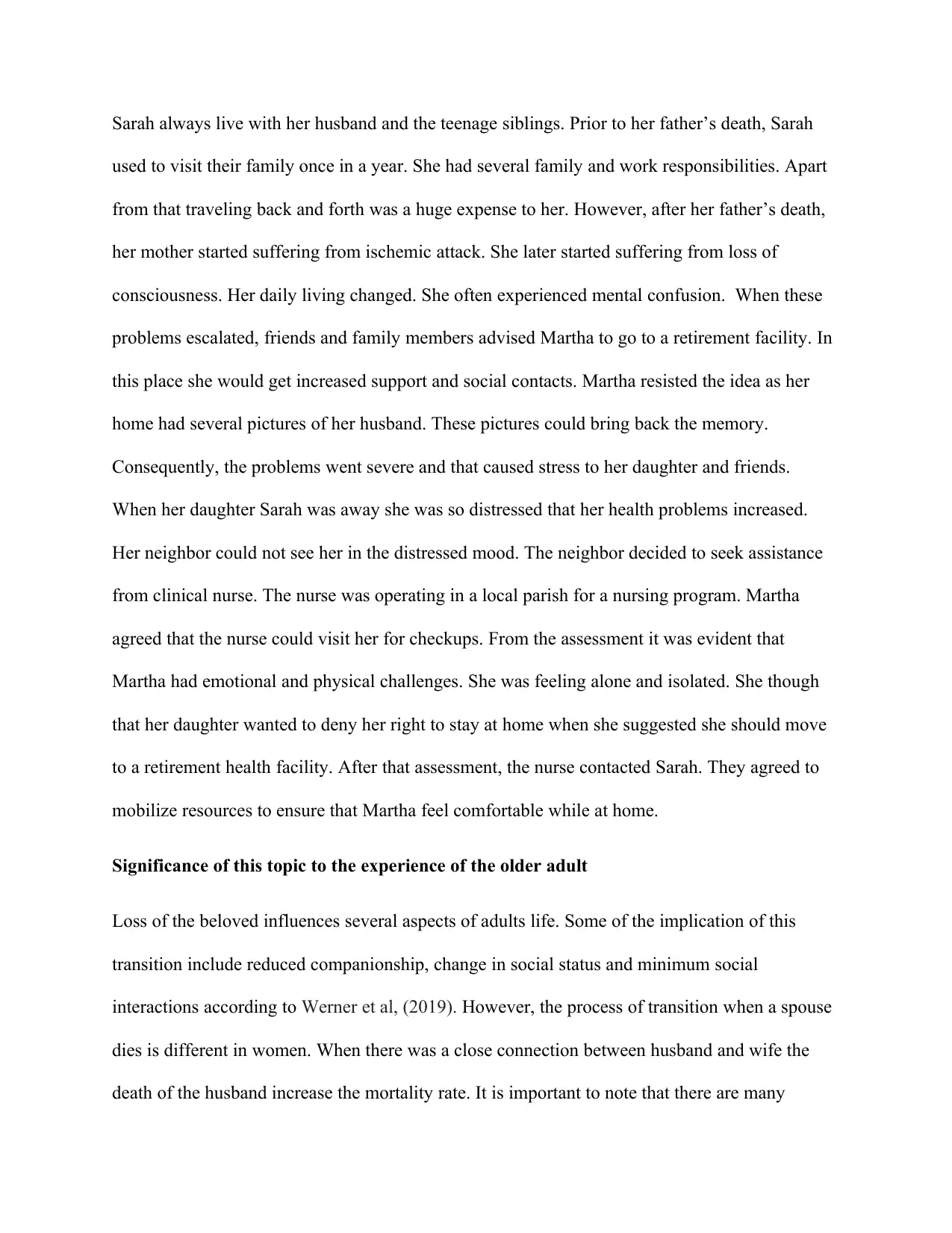
Sarah always live with her husband and the teenage siblings. Prior to her father’s death, Sarah
used to visit their family once in a year. She had several family and work responsibilities. Apart
from that traveling back and forth was a huge expense to her. However, after her father’s death,
her mother started suffering from ischemic attack. She later started suffering from loss of
consciousness. Her daily living changed. She often experienced mental confusion. When these
problems escalated, friends and family members advised Martha to go to a retirement facility. In
this place she would get increased support and social contacts. Martha resisted the idea as her
home had several pictures of her husband. These pictures could bring back the memory.
Consequently, the problems went severe and that caused stress to her daughter and friends.
When her daughter Sarah was away she was so distressed that her health problems increased.
Her neighbor could not see her in the distressed mood. The neighbor decided to seek assistance
from clinical nurse. The nurse was operating in a local parish for a nursing program. Martha
agreed that the nurse could visit her for checkups. From the assessment it was evident that
Martha had emotional and physical challenges. She was feeling alone and isolated. She though
that her daughter wanted to deny her right to stay at home when she suggested she should move
to a retirement health facility. After that assessment, the nurse contacted Sarah. They agreed to
mobilize resources to ensure that Martha feel comfortable while at home.
Significance of this topic to the experience of the older adult
Loss of the beloved influences several aspects of adults life. Some of the implication of this
transition include reduced companionship, change in social status and minimum social
interactions according to Werner et al, (2019). However, the process of transition when a spouse
dies is different in women. When there was a close connection between husband and wife the
death of the husband increase the mortality rate. It is important to note that there are many
used to visit their family once in a year. She had several family and work responsibilities. Apart
from that traveling back and forth was a huge expense to her. However, after her father’s death,
her mother started suffering from ischemic attack. She later started suffering from loss of
consciousness. Her daily living changed. She often experienced mental confusion. When these
problems escalated, friends and family members advised Martha to go to a retirement facility. In
this place she would get increased support and social contacts. Martha resisted the idea as her
home had several pictures of her husband. These pictures could bring back the memory.
Consequently, the problems went severe and that caused stress to her daughter and friends.
When her daughter Sarah was away she was so distressed that her health problems increased.
Her neighbor could not see her in the distressed mood. The neighbor decided to seek assistance
from clinical nurse. The nurse was operating in a local parish for a nursing program. Martha
agreed that the nurse could visit her for checkups. From the assessment it was evident that
Martha had emotional and physical challenges. She was feeling alone and isolated. She though
that her daughter wanted to deny her right to stay at home when she suggested she should move
to a retirement health facility. After that assessment, the nurse contacted Sarah. They agreed to
mobilize resources to ensure that Martha feel comfortable while at home.
Significance of this topic to the experience of the older adult
Loss of the beloved influences several aspects of adults life. Some of the implication of this
transition include reduced companionship, change in social status and minimum social
interactions according to Werner et al, (2019). However, the process of transition when a spouse
dies is different in women. When there was a close connection between husband and wife the
death of the husband increase the mortality rate. It is important to note that there are many
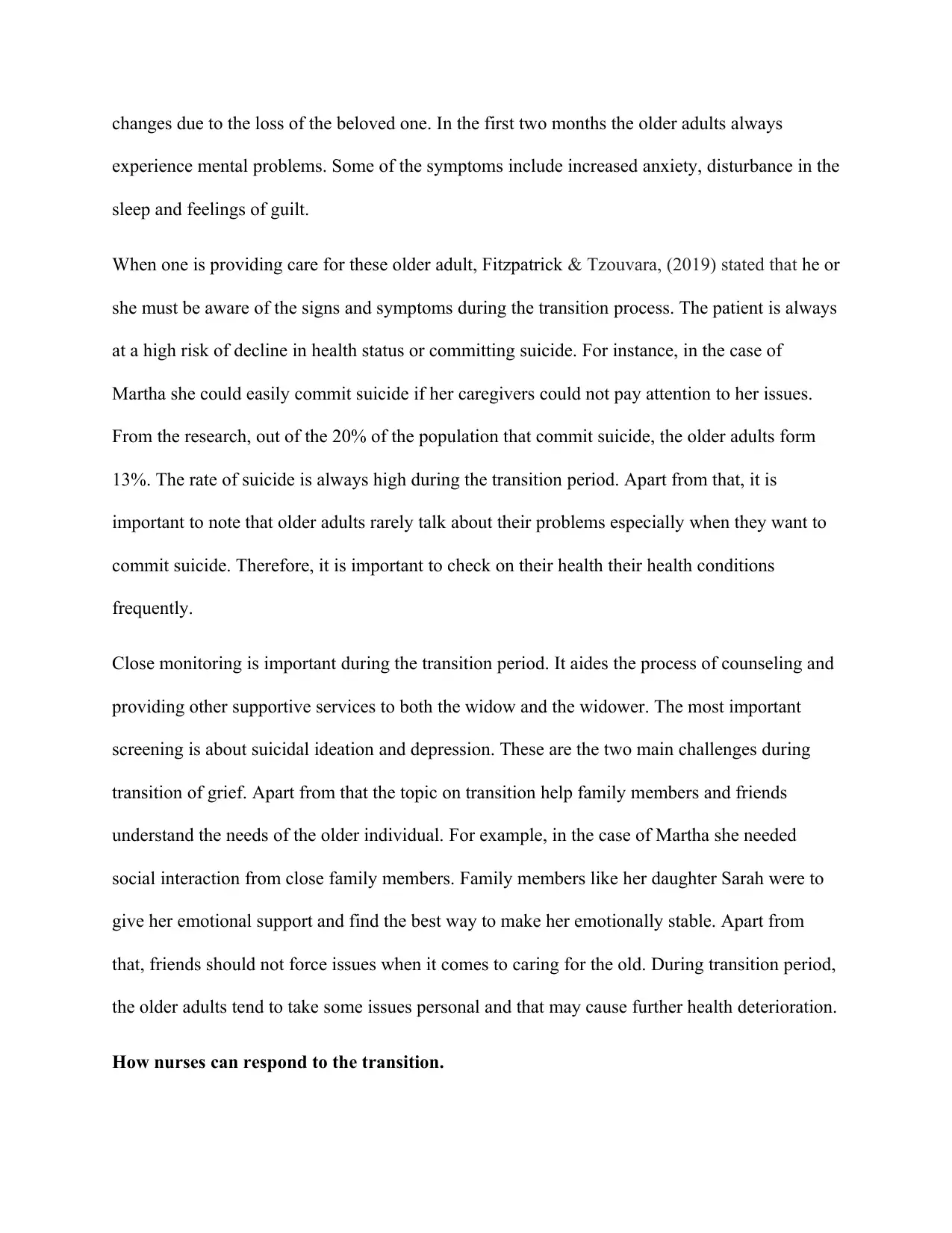
changes due to the loss of the beloved one. In the first two months the older adults always
experience mental problems. Some of the symptoms include increased anxiety, disturbance in the
sleep and feelings of guilt.
When one is providing care for these older adult, Fitzpatrick & Tzouvara, (2019) stated that he or
she must be aware of the signs and symptoms during the transition process. The patient is always
at a high risk of decline in health status or committing suicide. For instance, in the case of
Martha she could easily commit suicide if her caregivers could not pay attention to her issues.
From the research, out of the 20% of the population that commit suicide, the older adults form
13%. The rate of suicide is always high during the transition period. Apart from that, it is
important to note that older adults rarely talk about their problems especially when they want to
commit suicide. Therefore, it is important to check on their health their health conditions
frequently.
Close monitoring is important during the transition period. It aides the process of counseling and
providing other supportive services to both the widow and the widower. The most important
screening is about suicidal ideation and depression. These are the two main challenges during
transition of grief. Apart from that the topic on transition help family members and friends
understand the needs of the older individual. For example, in the case of Martha she needed
social interaction from close family members. Family members like her daughter Sarah were to
give her emotional support and find the best way to make her emotionally stable. Apart from
that, friends should not force issues when it comes to caring for the old. During transition period,
the older adults tend to take some issues personal and that may cause further health deterioration.
How nurses can respond to the transition.
experience mental problems. Some of the symptoms include increased anxiety, disturbance in the
sleep and feelings of guilt.
When one is providing care for these older adult, Fitzpatrick & Tzouvara, (2019) stated that he or
she must be aware of the signs and symptoms during the transition process. The patient is always
at a high risk of decline in health status or committing suicide. For instance, in the case of
Martha she could easily commit suicide if her caregivers could not pay attention to her issues.
From the research, out of the 20% of the population that commit suicide, the older adults form
13%. The rate of suicide is always high during the transition period. Apart from that, it is
important to note that older adults rarely talk about their problems especially when they want to
commit suicide. Therefore, it is important to check on their health their health conditions
frequently.
Close monitoring is important during the transition period. It aides the process of counseling and
providing other supportive services to both the widow and the widower. The most important
screening is about suicidal ideation and depression. These are the two main challenges during
transition of grief. Apart from that the topic on transition help family members and friends
understand the needs of the older individual. For example, in the case of Martha she needed
social interaction from close family members. Family members like her daughter Sarah were to
give her emotional support and find the best way to make her emotionally stable. Apart from
that, friends should not force issues when it comes to caring for the old. During transition period,
the older adults tend to take some issues personal and that may cause further health deterioration.
How nurses can respond to the transition.
Secure Best Marks with AI Grader
Need help grading? Try our AI Grader for instant feedback on your assignments.
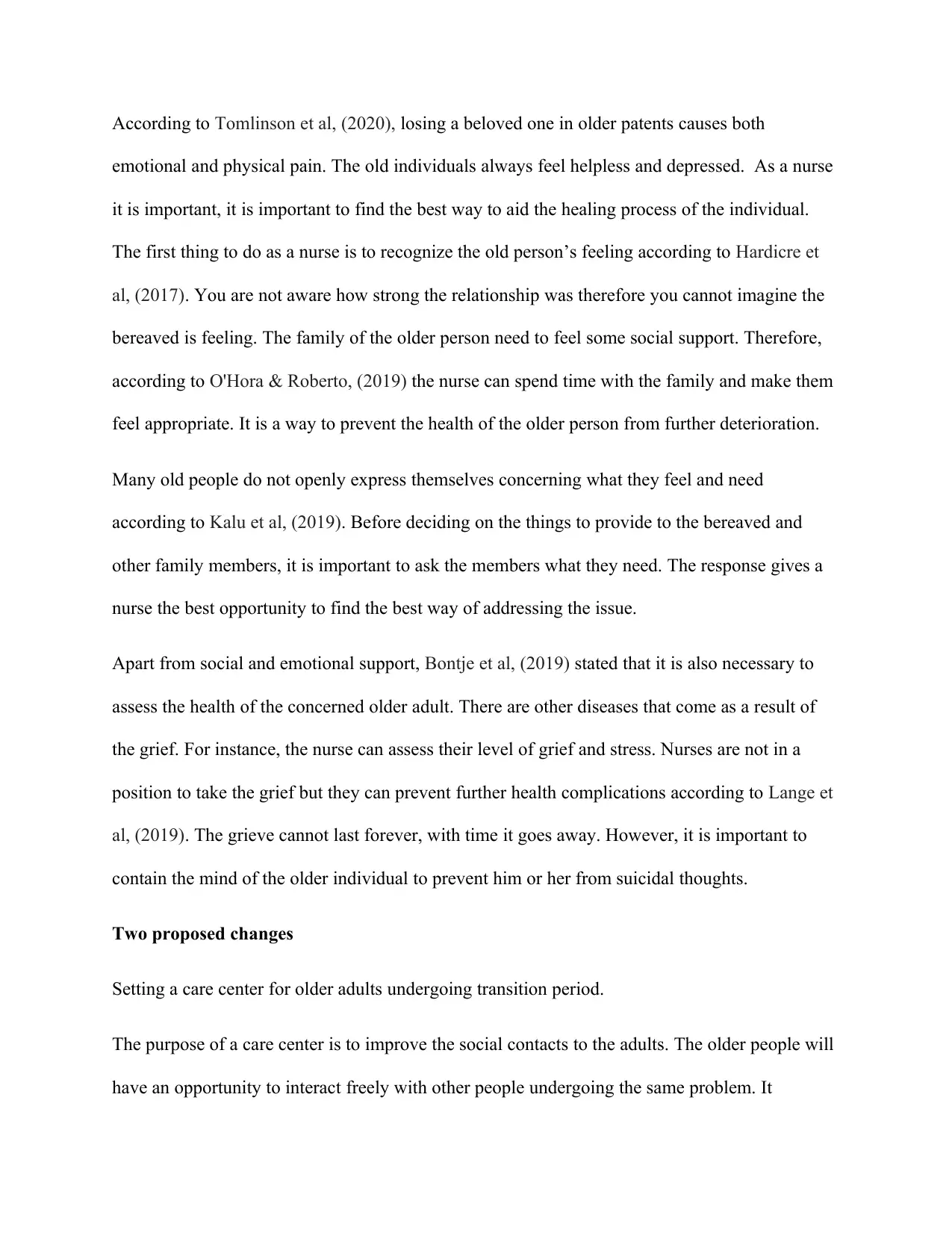
According to Tomlinson et al, (2020), losing a beloved one in older patents causes both
emotional and physical pain. The old individuals always feel helpless and depressed. As a nurse
it is important, it is important to find the best way to aid the healing process of the individual.
The first thing to do as a nurse is to recognize the old person’s feeling according to Hardicre et
al, (2017). You are not aware how strong the relationship was therefore you cannot imagine the
bereaved is feeling. The family of the older person need to feel some social support. Therefore,
according to O'Hora & Roberto, (2019) the nurse can spend time with the family and make them
feel appropriate. It is a way to prevent the health of the older person from further deterioration.
Many old people do not openly express themselves concerning what they feel and need
according to Kalu et al, (2019). Before deciding on the things to provide to the bereaved and
other family members, it is important to ask the members what they need. The response gives a
nurse the best opportunity to find the best way of addressing the issue.
Apart from social and emotional support, Bontje et al, (2019) stated that it is also necessary to
assess the health of the concerned older adult. There are other diseases that come as a result of
the grief. For instance, the nurse can assess their level of grief and stress. Nurses are not in a
position to take the grief but they can prevent further health complications according to Lange et
al, (2019). The grieve cannot last forever, with time it goes away. However, it is important to
contain the mind of the older individual to prevent him or her from suicidal thoughts.
Two proposed changes
Setting a care center for older adults undergoing transition period.
The purpose of a care center is to improve the social contacts to the adults. The older people will
have an opportunity to interact freely with other people undergoing the same problem. It
emotional and physical pain. The old individuals always feel helpless and depressed. As a nurse
it is important, it is important to find the best way to aid the healing process of the individual.
The first thing to do as a nurse is to recognize the old person’s feeling according to Hardicre et
al, (2017). You are not aware how strong the relationship was therefore you cannot imagine the
bereaved is feeling. The family of the older person need to feel some social support. Therefore,
according to O'Hora & Roberto, (2019) the nurse can spend time with the family and make them
feel appropriate. It is a way to prevent the health of the older person from further deterioration.
Many old people do not openly express themselves concerning what they feel and need
according to Kalu et al, (2019). Before deciding on the things to provide to the bereaved and
other family members, it is important to ask the members what they need. The response gives a
nurse the best opportunity to find the best way of addressing the issue.
Apart from social and emotional support, Bontje et al, (2019) stated that it is also necessary to
assess the health of the concerned older adult. There are other diseases that come as a result of
the grief. For instance, the nurse can assess their level of grief and stress. Nurses are not in a
position to take the grief but they can prevent further health complications according to Lange et
al, (2019). The grieve cannot last forever, with time it goes away. However, it is important to
contain the mind of the older individual to prevent him or her from suicidal thoughts.
Two proposed changes
Setting a care center for older adults undergoing transition period.
The purpose of a care center is to improve the social contacts to the adults. The older people will
have an opportunity to interact freely with other people undergoing the same problem. It
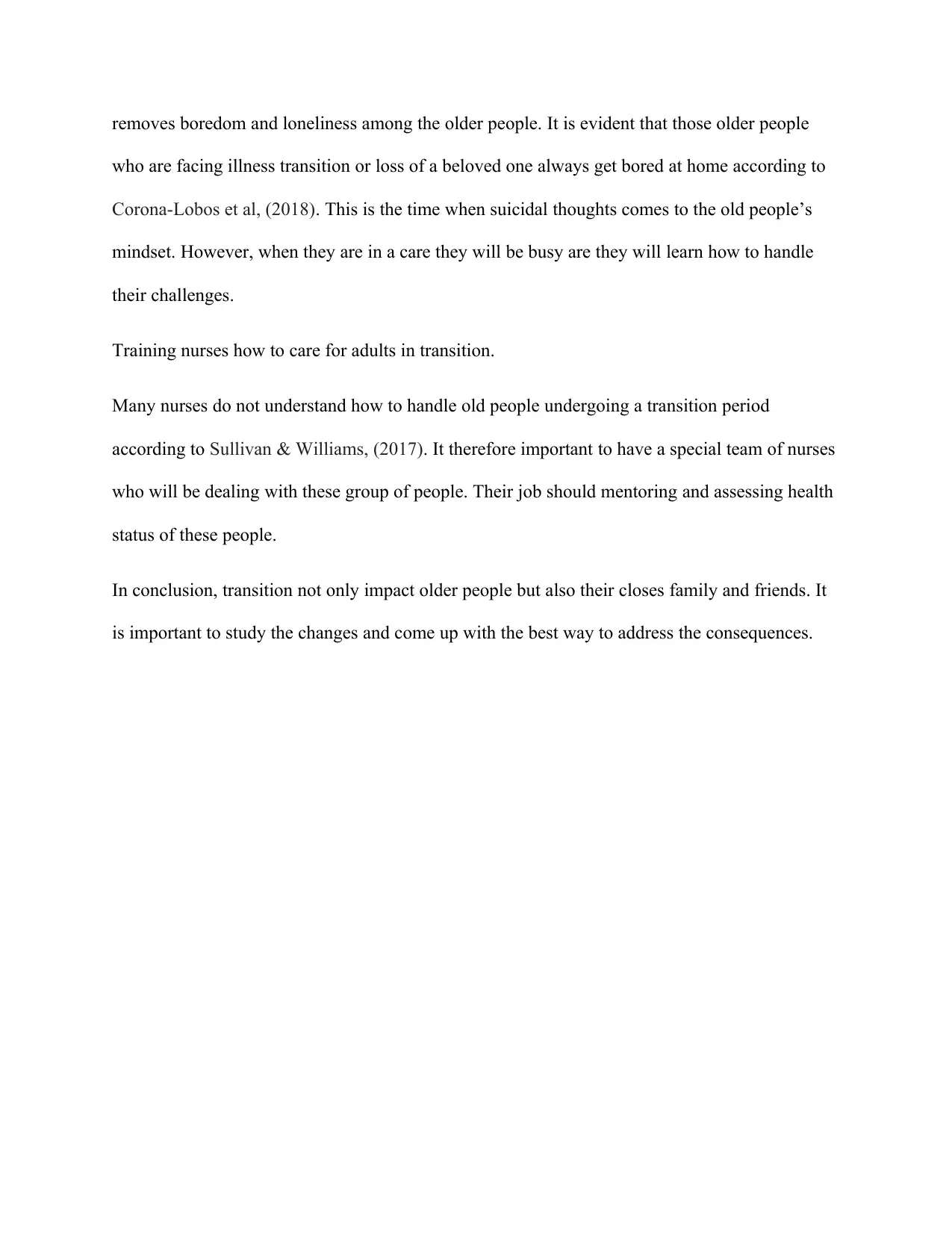
removes boredom and loneliness among the older people. It is evident that those older people
who are facing illness transition or loss of a beloved one always get bored at home according to
Corona-Lobos et al, (2018). This is the time when suicidal thoughts comes to the old people’s
mindset. However, when they are in a care they will be busy are they will learn how to handle
their challenges.
Training nurses how to care for adults in transition.
Many nurses do not understand how to handle old people undergoing a transition period
according to Sullivan & Williams, (2017). It therefore important to have a special team of nurses
who will be dealing with these group of people. Their job should mentoring and assessing health
status of these people.
In conclusion, transition not only impact older people but also their closes family and friends. It
is important to study the changes and come up with the best way to address the consequences.
who are facing illness transition or loss of a beloved one always get bored at home according to
Corona-Lobos et al, (2018). This is the time when suicidal thoughts comes to the old people’s
mindset. However, when they are in a care they will be busy are they will learn how to handle
their challenges.
Training nurses how to care for adults in transition.
Many nurses do not understand how to handle old people undergoing a transition period
according to Sullivan & Williams, (2017). It therefore important to have a special team of nurses
who will be dealing with these group of people. Their job should mentoring and assessing health
status of these people.
In conclusion, transition not only impact older people but also their closes family and friends. It
is important to study the changes and come up with the best way to address the consequences.
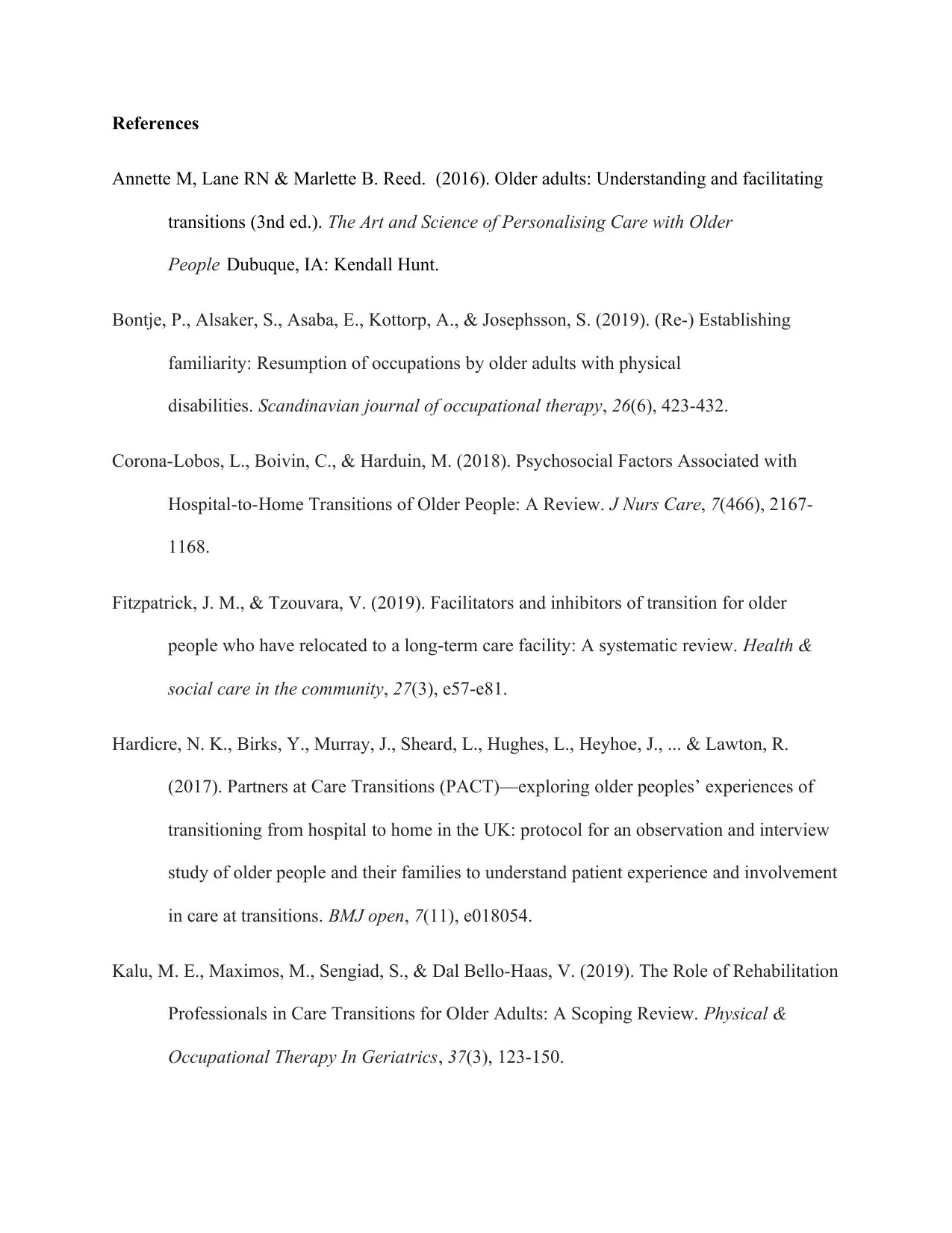
References
Annette M, Lane RN & Marlette B. Reed. (2016). Older adults: Understanding and facilitating
transitions (3nd ed.). The Art and Science of Personalising Care with Older
People Dubuque, IA: Kendall Hunt.
Bontje, P., Alsaker, S., Asaba, E., Kottorp, A., & Josephsson, S. (2019). (Re-) Establishing
familiarity: Resumption of occupations by older adults with physical
disabilities. Scandinavian journal of occupational therapy, 26(6), 423-432.
Corona-Lobos, L., Boivin, C., & Harduin, M. (2018). Psychosocial Factors Associated with
Hospital-to-Home Transitions of Older People: A Review. J Nurs Care, 7(466), 2167-
1168.
Fitzpatrick, J. M., & Tzouvara, V. (2019). Facilitators and inhibitors of transition for older
people who have relocated to a long term care facility: A systematic review.‐ Health &
social care in the community, 27(3), e57-e81.
Hardicre, N. K., Birks, Y., Murray, J., Sheard, L., Hughes, L., Heyhoe, J., ... & Lawton, R.
(2017). Partners at Care Transitions (PACT)—exploring older peoples’ experiences of
transitioning from hospital to home in the UK: protocol for an observation and interview
study of older people and their families to understand patient experience and involvement
in care at transitions. BMJ open, 7(11), e018054.
Kalu, M. E., Maximos, M., Sengiad, S., & Dal Bello-Haas, V. (2019). The Role of Rehabilitation
Professionals in Care Transitions for Older Adults: A Scoping Review. Physical &
Occupational Therapy In Geriatrics, 37(3), 123-150.
Annette M, Lane RN & Marlette B. Reed. (2016). Older adults: Understanding and facilitating
transitions (3nd ed.). The Art and Science of Personalising Care with Older
People Dubuque, IA: Kendall Hunt.
Bontje, P., Alsaker, S., Asaba, E., Kottorp, A., & Josephsson, S. (2019). (Re-) Establishing
familiarity: Resumption of occupations by older adults with physical
disabilities. Scandinavian journal of occupational therapy, 26(6), 423-432.
Corona-Lobos, L., Boivin, C., & Harduin, M. (2018). Psychosocial Factors Associated with
Hospital-to-Home Transitions of Older People: A Review. J Nurs Care, 7(466), 2167-
1168.
Fitzpatrick, J. M., & Tzouvara, V. (2019). Facilitators and inhibitors of transition for older
people who have relocated to a long term care facility: A systematic review.‐ Health &
social care in the community, 27(3), e57-e81.
Hardicre, N. K., Birks, Y., Murray, J., Sheard, L., Hughes, L., Heyhoe, J., ... & Lawton, R.
(2017). Partners at Care Transitions (PACT)—exploring older peoples’ experiences of
transitioning from hospital to home in the UK: protocol for an observation and interview
study of older people and their families to understand patient experience and involvement
in care at transitions. BMJ open, 7(11), e018054.
Kalu, M. E., Maximos, M., Sengiad, S., & Dal Bello-Haas, V. (2019). The Role of Rehabilitation
Professionals in Care Transitions for Older Adults: A Scoping Review. Physical &
Occupational Therapy In Geriatrics, 37(3), 123-150.
Paraphrase This Document
Need a fresh take? Get an instant paraphrase of this document with our AI Paraphraser
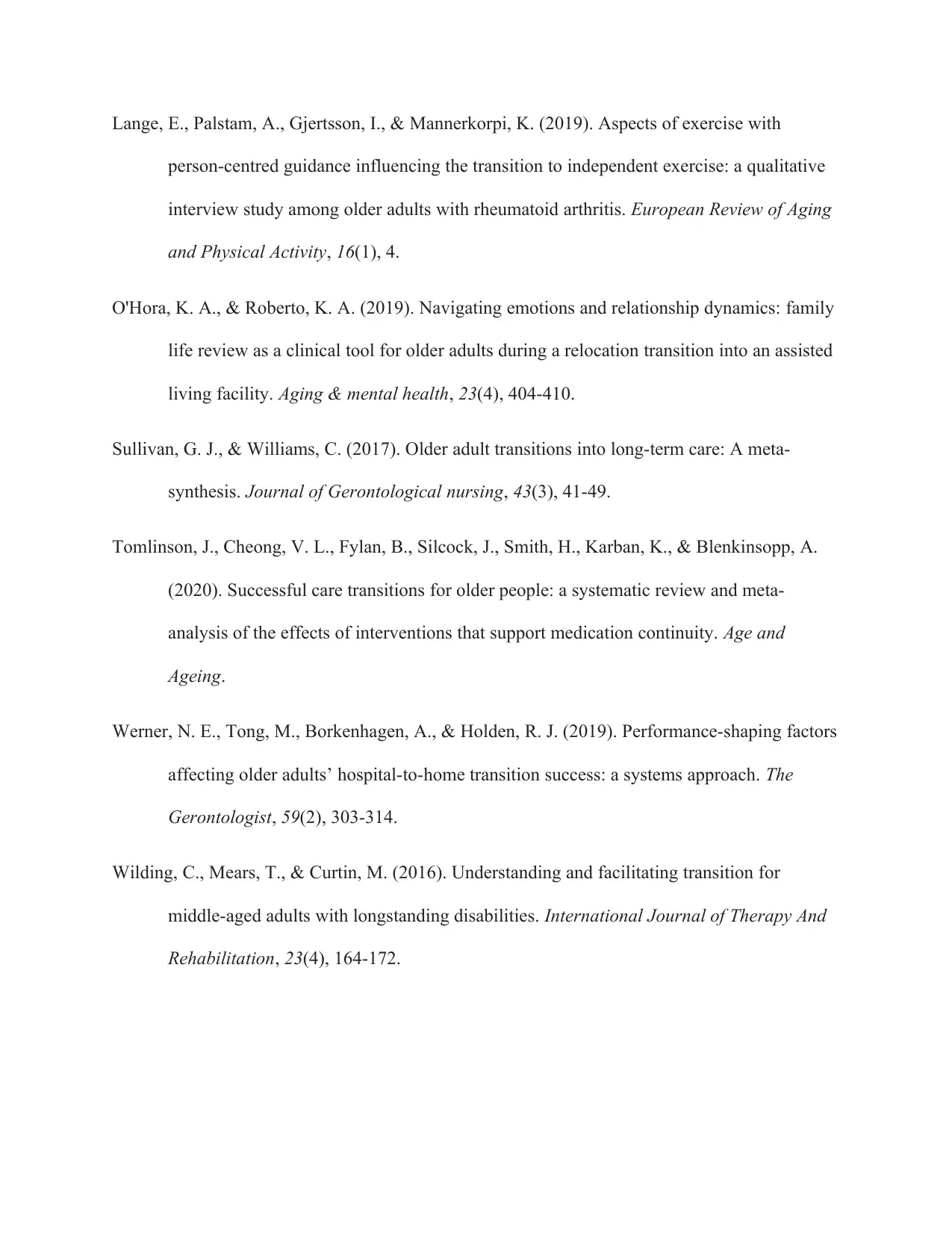
Lange, E., Palstam, A., Gjertsson, I., & Mannerkorpi, K. (2019). Aspects of exercise with
person-centred guidance influencing the transition to independent exercise: a qualitative
interview study among older adults with rheumatoid arthritis. European Review of Aging
and Physical Activity, 16(1), 4.
O'Hora, K. A., & Roberto, K. A. (2019). Navigating emotions and relationship dynamics: family
life review as a clinical tool for older adults during a relocation transition into an assisted
living facility. Aging & mental health, 23(4), 404-410.
Sullivan, G. J., & Williams, C. (2017). Older adult transitions into long-term care: A meta-
synthesis. Journal of Gerontological nursing, 43(3), 41-49.
Tomlinson, J., Cheong, V. L., Fylan, B., Silcock, J., Smith, H., Karban, K., & Blenkinsopp, A.
(2020). Successful care transitions for older people: a systematic review and meta-
analysis of the effects of interventions that support medication continuity. Age and
Ageing.
Werner, N. E., Tong, M., Borkenhagen, A., & Holden, R. J. (2019). Performance-shaping factors
affecting older adults’ hospital-to-home transition success: a systems approach. The
Gerontologist, 59(2), 303-314.
Wilding, C., Mears, T., & Curtin, M. (2016). Understanding and facilitating transition for
middle-aged adults with longstanding disabilities. International Journal of Therapy And
Rehabilitation, 23(4), 164-172.
person-centred guidance influencing the transition to independent exercise: a qualitative
interview study among older adults with rheumatoid arthritis. European Review of Aging
and Physical Activity, 16(1), 4.
O'Hora, K. A., & Roberto, K. A. (2019). Navigating emotions and relationship dynamics: family
life review as a clinical tool for older adults during a relocation transition into an assisted
living facility. Aging & mental health, 23(4), 404-410.
Sullivan, G. J., & Williams, C. (2017). Older adult transitions into long-term care: A meta-
synthesis. Journal of Gerontological nursing, 43(3), 41-49.
Tomlinson, J., Cheong, V. L., Fylan, B., Silcock, J., Smith, H., Karban, K., & Blenkinsopp, A.
(2020). Successful care transitions for older people: a systematic review and meta-
analysis of the effects of interventions that support medication continuity. Age and
Ageing.
Werner, N. E., Tong, M., Borkenhagen, A., & Holden, R. J. (2019). Performance-shaping factors
affecting older adults’ hospital-to-home transition success: a systems approach. The
Gerontologist, 59(2), 303-314.
Wilding, C., Mears, T., & Curtin, M. (2016). Understanding and facilitating transition for
middle-aged adults with longstanding disabilities. International Journal of Therapy And
Rehabilitation, 23(4), 164-172.
1 out of 8
Related Documents
Your All-in-One AI-Powered Toolkit for Academic Success.
+13062052269
info@desklib.com
Available 24*7 on WhatsApp / Email
![[object Object]](/_next/static/media/star-bottom.7253800d.svg)
Unlock your academic potential
© 2024 | Zucol Services PVT LTD | All rights reserved.





